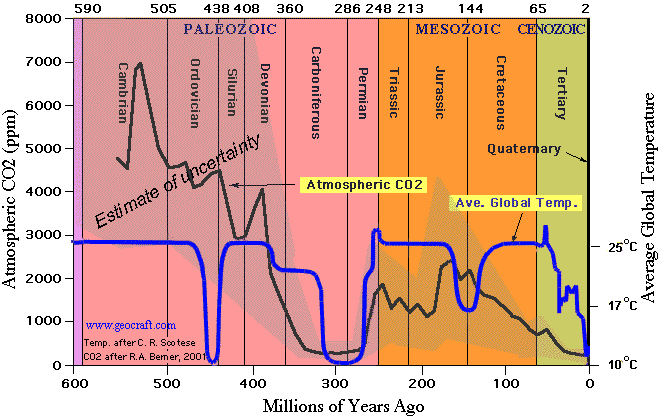Collection of five Surrey Mirror Group Website Articles written by Peter F Gill and posted from about March 2015 to January 2016. They now no longer exist on the Internet unless archived by someone.
In previous contributions (scroll down to previous of my blogs if you need to catch-up) I have described and, in a limited way, discussed the first four of the main six hypotheses that form the overall Anthropogenic Global Warming (AGW) hypothesis. Now we shall move on to the final two which I listed as: (v) further atmospheric heating will release methane from permafrost causing run-away global warming and finally (vi) the amount of carbon dioxide in the atmosphere is and always has been the main climate driver.
AGW Hypothesis (v) further atmospheric heating will release methane from permafrost and cause run-away global warming
In one sense, we may regard this aspect of concern as a consequence of warming (of any origin) like increased sea levels. However because it is thought that the release of methane would lead to even more warming such a consequence maybe classed as a positive feedback which some have argued could lead to a tipping point and runaway warming.
Atmospheric methane (CH4) levels are very much lower than carbon dioxide (CO2) levels by volume. Whereas carbon dioxide levels are measured in parts per million (currently circa 400ppmv), methane levels are measured in parts per billion (currently circa 1825 ppbv). As with the origin of the CO2 increase, there is not universal acceptance about anthropogenic versus natural contributions. CH4 is a more potent Green House Gas (GHG) than CO2 by a variable factor currently close to about 30 times.
Whilst there has clearly been warming since the depths of the Little Ice Age (LIA) compared to previous recent warm periods the present warm period is not as far as proxy data shows anything extraordinary. The Roman Warm Period (RWP) was almost certainly warmer than the present warm period. The Medieval Warm Period (MWP) was probably warmer than the present warm period. Going back earlier in the present Holocene era the Holocene optimum was very much warmer than the present. In all of these cases, there is no evidence of runaway warming due to CH4 released from permafrost.
As we have raised the subject of feedbacks, it is worth mentioning some others. Interestingly those who favour the overall AGW hypothesis tend to concentrate on positive feedbacks of which CH4 release is clearly one. Loss of snow and ice reduce the amount of electromagnetic energy that is reflected from the Earth and therefore such warming causes further warming. However, that said I suspect that the elephant in the room is the negative feedbacks due to water in its various forms clouds and precipitation from clouds in particular.
AGW Hypothesis (vi) the amount of carbon dioxide in the atmosphere is and always has been the main climate driver.
When I first got involved in the whole notion of AGW back in the 1990s the climate change community readily admitted that there were many factors driving climate change and changes in atmospheric CO2 was just one of them. Things have apparently changed in recent years. I attended a two-day meeting at the Royal Society in October 2011 entitled “Warm climates of the past – lessons for the future?” Although the meeting only concerned itself with very recent times (the last circa 50 million years) it was concluded that carbon dioxide in the atmosphere is now and has in the past been the main climate driver. This is the most recent main claim by those supporting the AGW hypothesis, which as far as I can see goes contrary to most of the proxy data available for the last 600 million years. In concluding this part of the discussion below, I provide a composite picture of data from C.R. Scotese who generated the average global temperature data and R.A. Berner who generated the atmospheric carbon dioxide data.
I could make many points about this data. However, in relation to the main thrust of the Royal Society meeting the following are appropriate:
- Whilst the uncertainty in proxy data is large, it is clear that over the last 600 million years there is no obvious correlation between atmospheric carbon dioxide and temperature.
- The period chosen by the Royal Society for its meeting was one in which in the movement of both temperature and CO2 were broadly in the same direction. For most of the rest of the period, this is clearly not the case.
- For approximately 80% of the period the Earth’s average temperature has been some 6-80C above the present average. This was true in the late Devonian and the early Carboniferous despite rapidly reducing atmospheric CO2.
- The fact that there seems to be a limit on average global temperature around 220C suggests a negative feedback mechanism in place for which, in my opinion, water vapour effects are favourite.
- Average Earth temperatures in the last part of the Ordovician were quite a lot lower than the current average temperature despite the fact that atmospheric CO2 content was circa 4000ppmv i.e. ten times current levels.
- The huge changes in climate evident from the proxy data require understanding beyond a simplistic CO2 in charge mantra.
Next time I hope to answer some comments people have made and to move on to a discussion of the missing science in climate change.


